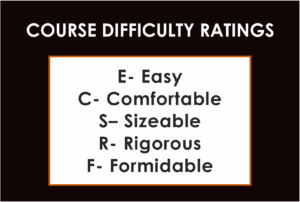Explanations of Course Difficulty Designations
 The COURSE DIFFICULTY RATING SYSTEM was put in place not only to help students decide which courses to take, be also, when to take them. Sometimes it’s wise to successfully complete easier courses before more difficult ones.
The COURSE DIFFICULTY RATING SYSTEM was put in place not only to help students decide which courses to take, be also, when to take them. Sometimes it’s wise to successfully complete easier courses before more difficult ones.
Ratings are: E- Easy • C- Comfortable • S- Sizeable • R- Rigorous • F- Formidable
Factor categories which determine course ratings: STUDENT PREPAREDNESS, MATERIAL COMPLEXITY, QUANTITY OF MATERIAL, RETENTION/ASSESSMENT.
FACTORS
STUDENT PREPAREDNESS:
• Expected incoming familiarity with topic
• Topic contoversiality
• Prerequisite requirement
MATERIAL COMPLEXITY:
• Subject depth
• Textbook-author writing style
• Quantity of technical terminology
• Inclusion of study guides
• Inclusion of videos or Power-Point lessons
QUANTITY OF MATERIAL:
• Textbook dimensions
• Quantity of pages
• Length of chapters
• Quantity of detail expected to be retained
• Inclusion of midterms and finals
• Overall number of quiz-questions
• Written or media submission requirement
SUMMARY
E (Easy)
This designation indicates the course falls at the simplest end of the academic spectrum compared to other offerings. Most factors considered — such as workload, subject depth, and quiz demands — contribute to the course being classified as easy.
C (Comfortable)
This rating signifies the course is on the easier side of the spectrum, though not at the lowest level. The volume of material is moderate, and the number of quiz questions is neither large nor small. The curriculum may be intentionally designed with limited depth. Overall, the course should be manageable and comfortable for the majority of students.
S (Sizeable)
This designation indicates that the course remains comfortable in terms of comprehension and assessment, but includes a larger volume of material than typical “comfortable” courses. The subject matter is accessible, with quiz demands aligned to the depth of the content. What sets a sizable course apart is its expanded scope—more textbook chapters, lessons, or instructional hours—requiring additional time while staying manageable for most students..
R (Rigorous)
Courses classified as rigorous invite students to explore subjects in greater depth. Because detail is important for these topics, rigorous courses typically offer more material and a richer level of content to absorb and retain. With steady engagement, these courses remain accessible and are in no way overwhelming. They are designed to foster meaningful academic and spiritual growth and to yield deeper educational benefits.
F (Formidable)
This category signals that the course demands exceptional commitment, intense concentration, and sustained study to succeed— particularly on quizzes and assessments. Such courses can be overwhelming for some students and are intended for those seeking a significant academic challenge. Sword & Spirit Seminary currently does not offer any courses classified as formidable, in keeping with our educational mission.
DIFFICULTY RATINGS ‒ ALL 40 COURSES
NOT INCLUDING GENERAL INSTRUCTIONS, BRIDGE ESSAY, THESIS, DISSERTATION OR PRACTICUM
EASY COURSES‒ 8
Bridge Program
• BRIDGE401‒ Sharpening Your Reading Skills
Biblical Interpretation & Preaching
Theology & Church History
Bible Knowledge
Apologetics & Evangelism
Counseling, Transformation & Spiritual Power
Leadership, Ethics & Citizenship
COMFORTABLE COURSES‒ 10
Bridge Program
• BRIDGE402‒ Critical Thinking Essentials
• BRIDGE403‒ Power & Clarity in Written Expression
Biblical Interpretation & Preaching
• BIP505‒ Jesus: Teaching Methods & Messages
Theology & Church History
Bible Knowledge
Apologetics & Evangelism
Counseling, Transformation & Spiritual Power
Leadership, Ethics & Citizenship
SIZABLE COURSES- 7
Bridge Program
Biblical Interpretation & Preaching
Theology & Church History
Bible Knowledge
Apologetics & Evangelism
Counseling, Transformation & Spiritual Power
• CTSP601‒ Deliverance Counseling Foundations & Practice
Leadership, Ethics & Citizenship
RIGOROUS COURSES- 16
Bridge Program
• BRIDGE405‒ Putting It All Together
Biblical Interpretation & Preaching
Theology & Church History
Bible Knowledge
• BK502.1‒ The New Testament In Its World
• BK502.4‒ Paul & His Epistles
• BK505.5‒ New Testament Authors & Letters